VAUXHALL VIVARO 2019 Workshop Manual
Manufacturer: VAUXHALL, Model Year: 2019, Model line: VIVARO, Model: VAUXHALL VIVARO 2019Pages: 231, PDF Size: 5.82 MB
Page 51 of 231
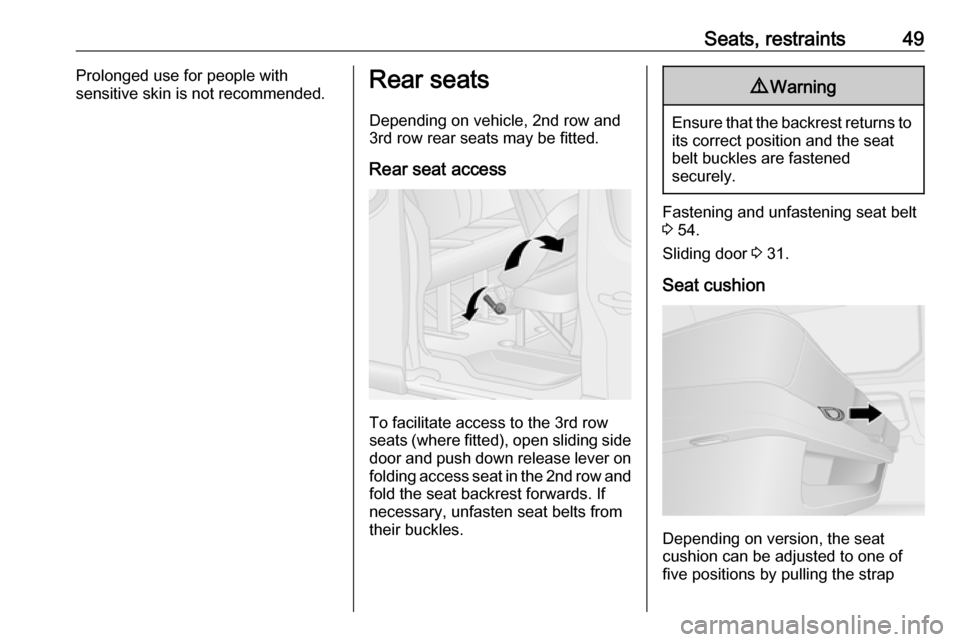
Seats, restraints49Prolonged use for people with
sensitive skin is not recommended.Rear seats
Depending on vehicle, 2nd row and
3rd row rear seats may be fitted.
Rear seat access
To facilitate access to the 3rd row
seats (where fitted), open sliding side door and push down release lever on folding access seat in the 2nd row and
fold the seat backrest forwards. If
necessary, unfasten seat belts from
their buckles.
9 Warning
Ensure that the backrest returns to
its correct position and the seat
belt buckles are fastened
securely.
Fastening and unfastening seat belt 3 54.
Sliding door 3 31.
Seat cushion
Depending on version, the seat
cushion can be adjusted to one of
five positions by pulling the strap
Page 52 of 231
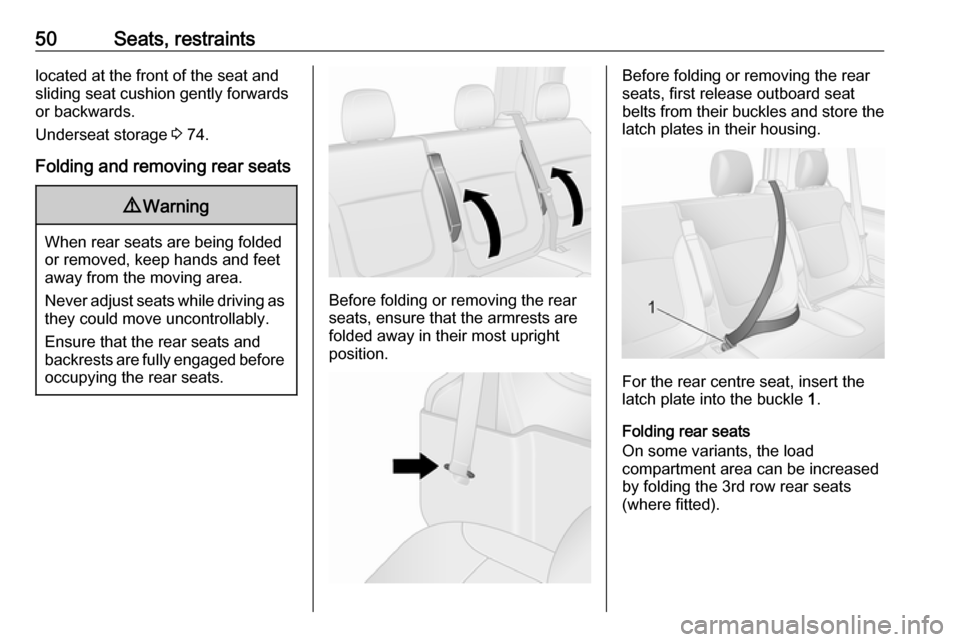
50Seats, restraintslocated at the front of the seat and
sliding seat cushion gently forwards
or backwards.
Underseat storage 3 74.
Folding and removing rear seats9 Warning
When rear seats are being folded
or removed, keep hands and feet
away from the moving area.
Never adjust seats while driving as they could move uncontrollably.
Ensure that the rear seats and
backrests are fully engaged before occupying the rear seats.
Before folding or removing the rearseats, ensure that the armrests are
folded away in their most upright
position.
Before folding or removing the rear
seats, first release outboard seat belts from their buckles and store the
latch plates in their housing.
For the rear centre seat, insert the
latch plate into the buckle 1.
Folding rear seats
On some variants, the load compartment area can be increased
by folding the 3rd row rear seats
(where fitted).
Page 53 of 231
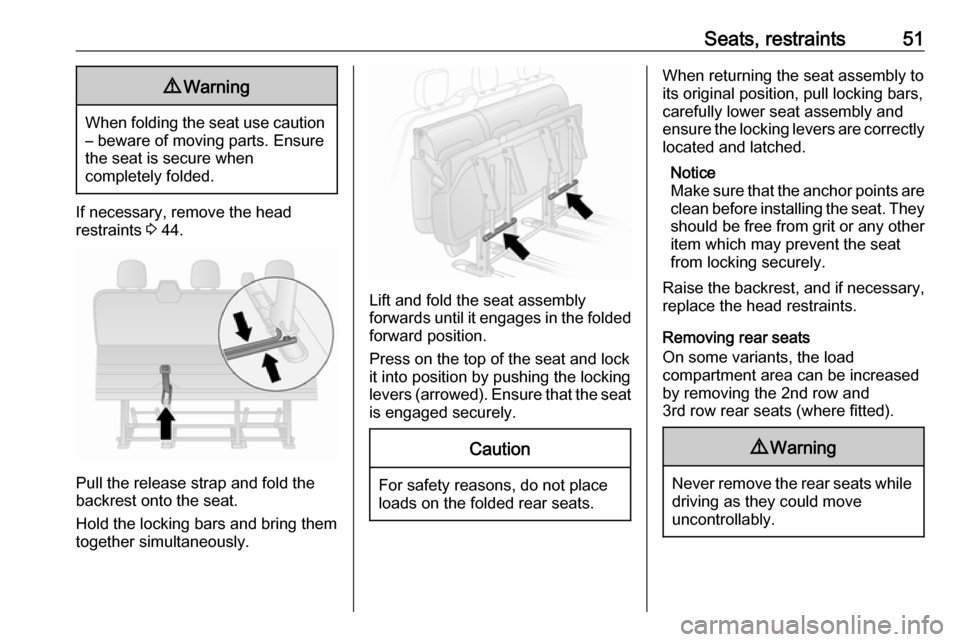
Seats, restraints519Warning
When folding the seat use caution
– beware of moving parts. Ensure
the seat is secure when
completely folded.
If necessary, remove the head
restraints 3 44.
Pull the release strap and fold the
backrest onto the seat.
Hold the locking bars and bring them
together simultaneously.
Lift and fold the seat assembly
forwards until it engages in the folded
forward position.
Press on the top of the seat and lock
it into position by pushing the locking
levers (arrowed). Ensure that the seat
is engaged securely.
Caution
For safety reasons, do not place
loads on the folded rear seats.
When returning the seat assembly to its original position, pull locking bars,
carefully lower seat assembly and
ensure the locking levers are correctly located and latched.
Notice
Make sure that the anchor points are
clean before installing the seat. They should be free from grit or any other
item which may prevent the seat
from locking securely.
Raise the backrest, and if necessary,
replace the head restraints.
Removing rear seats
On some variants, the load
compartment area can be increased
by removing the 2nd row and
3rd row rear seats (where fitted).9 Warning
Never remove the rear seats while
driving as they could move
uncontrollably.
Page 54 of 231
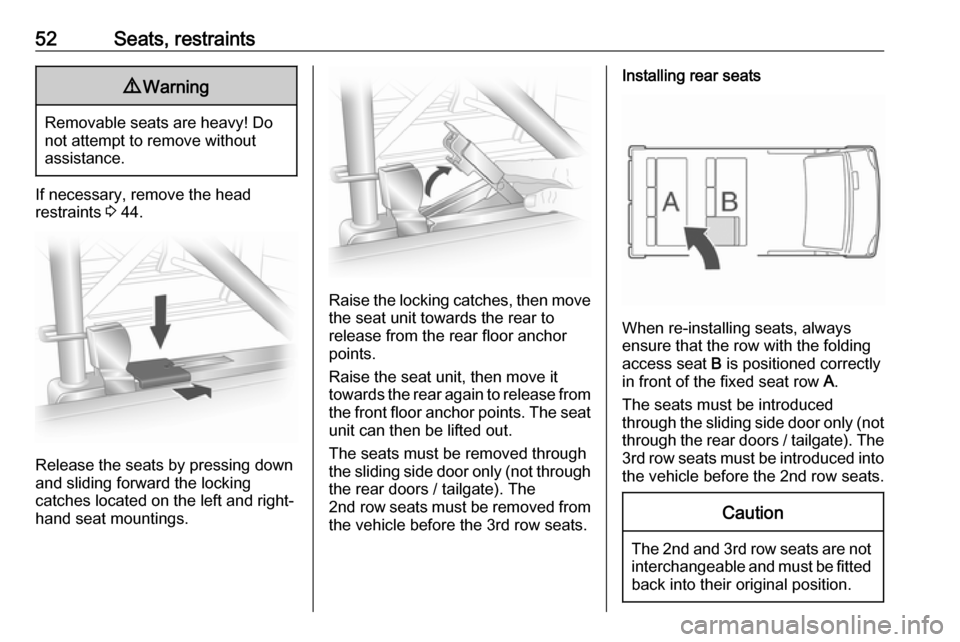
52Seats, restraints9Warning
Removable seats are heavy! Do
not attempt to remove without
assistance.
If necessary, remove the head
restraints 3 44.
Release the seats by pressing down
and sliding forward the locking
catches located on the left and right-
hand seat mountings.
Raise the locking catches, then move the seat unit towards the rear to
release from the rear floor anchor
points.
Raise the seat unit, then move it
towards the rear again to release from
the front floor anchor points. The seat unit can then be lifted out.
The seats must be removed through
the sliding side door only (not through
the rear doors / tailgate). The
2nd row seats must be removed from
the vehicle before the 3rd row seats.
Installing rear seats
When re-installing seats, always
ensure that the row with the folding
access seat B is positioned correctly
in front of the fixed seat row A.
The seats must be introduced
through the sliding side door only (not
through the rear doors / tailgate). The
3rd row seats must be introduced into the vehicle before the 2nd row seats.
Caution
The 2nd and 3rd row seats are not
interchangeable and must be fitted back into their original position.
Page 55 of 231
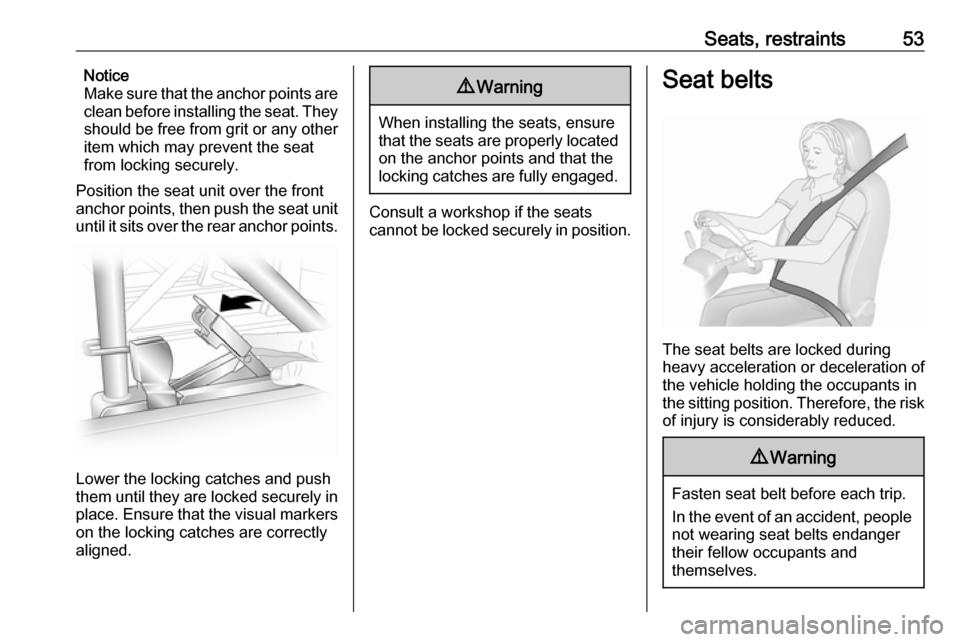
Seats, restraints53Notice
Make sure that the anchor points are
clean before installing the seat. They
should be free from grit or any other
item which may prevent the seat
from locking securely.
Position the seat unit over the front
anchor points, then push the seat unit until it sits over the rear anchor points.
Lower the locking catches and push
them until they are locked securely in place. Ensure that the visual markers
on the locking catches are correctly
aligned.
9 Warning
When installing the seats, ensure
that the seats are properly located
on the anchor points and that the
locking catches are fully engaged.
Consult a workshop if the seats
cannot be locked securely in position.
Seat belts
The seat belts are locked during
heavy acceleration or deceleration of
the vehicle holding the occupants in
the sitting position. Therefore, the risk of injury is considerably reduced.
9 Warning
Fasten seat belt before each trip.
In the event of an accident, people
not wearing seat belts endanger their fellow occupants and
themselves.
Page 56 of 231
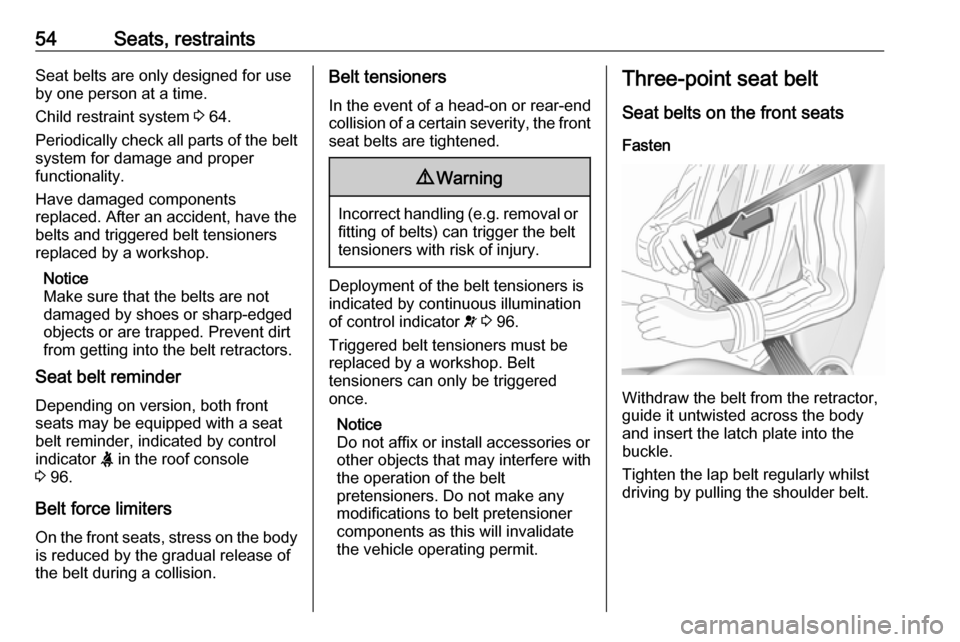
54Seats, restraintsSeat belts are only designed for use
by one person at a time.
Child restraint system 3 64.
Periodically check all parts of the belt system for damage and proper
functionality.
Have damaged components
replaced. After an accident, have the
belts and triggered belt tensioners
replaced by a workshop.
Notice
Make sure that the belts are not
damaged by shoes or sharp-edged
objects or are trapped. Prevent dirt
from getting into the belt retractors.
Seat belt reminder
Depending on version, both front
seats may be equipped with a seat
belt reminder, indicated by control
indicator X in the roof console
3 96.
Belt force limiters
On the front seats, stress on the body is reduced by the gradual release of
the belt during a collision.Belt tensioners
In the event of a head-on or rear-end
collision of a certain severity, the front
seat belts are tightened.9 Warning
Incorrect handling (e.g. removal or
fitting of belts) can trigger the belt
tensioners with risk of injury.
Deployment of the belt tensioners is
indicated by continuous illumination
of control indicator v 3 96.
Triggered belt tensioners must be
replaced by a workshop. Belt
tensioners can only be triggered
once.
Notice
Do not affix or install accessories or
other objects that may interfere with
the operation of the belt
pretensioners. Do not make any
modifications to belt pretensioner components as this will invalidate
the vehicle operating permit.
Three-point seat belt
Seat belts on the front seats Fasten
Withdraw the belt from the retractor,
guide it untwisted across the body
and insert the latch plate into the
buckle.
Tighten the lap belt regularly whilst
driving by pulling the shoulder belt.
Page 57 of 231
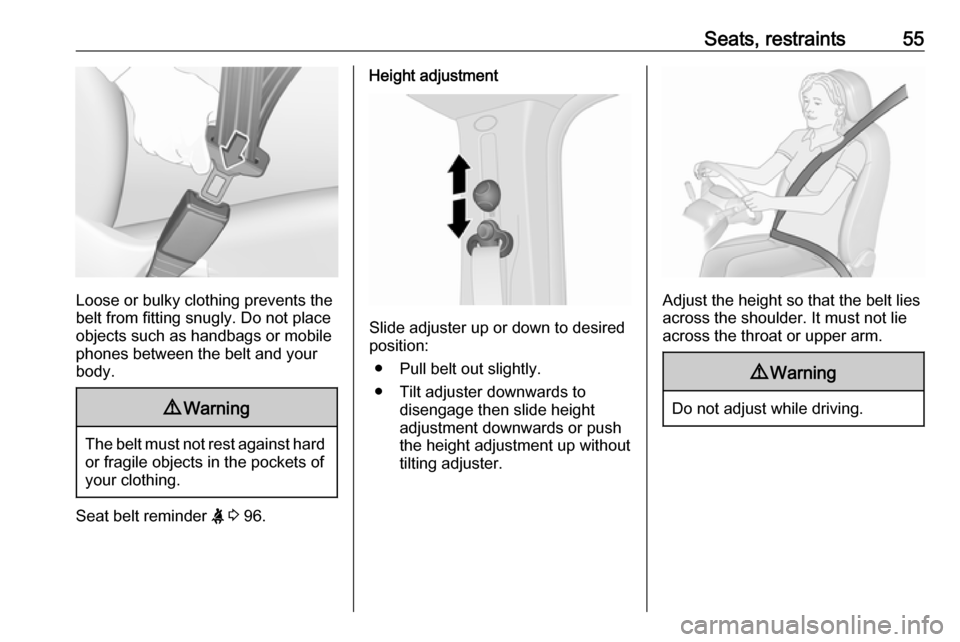
Seats, restraints55
Loose or bulky clothing prevents the
belt from fitting snugly. Do not place
objects such as handbags or mobile
phones between the belt and your body.
9 Warning
The belt must not rest against hard
or fragile objects in the pockets of
your clothing.
Seat belt reminder X 3 96.
Height adjustment
Slide adjuster up or down to desired
position:
● Pull belt out slightly.
● Tilt adjuster downwards to disengage then slide height
adjustment downwards or push
the height adjustment up without
tilting adjuster.
Adjust the height so that the belt lies across the shoulder. It must not lie
across the throat or upper arm.
9 Warning
Do not adjust while driving.
Page 58 of 231
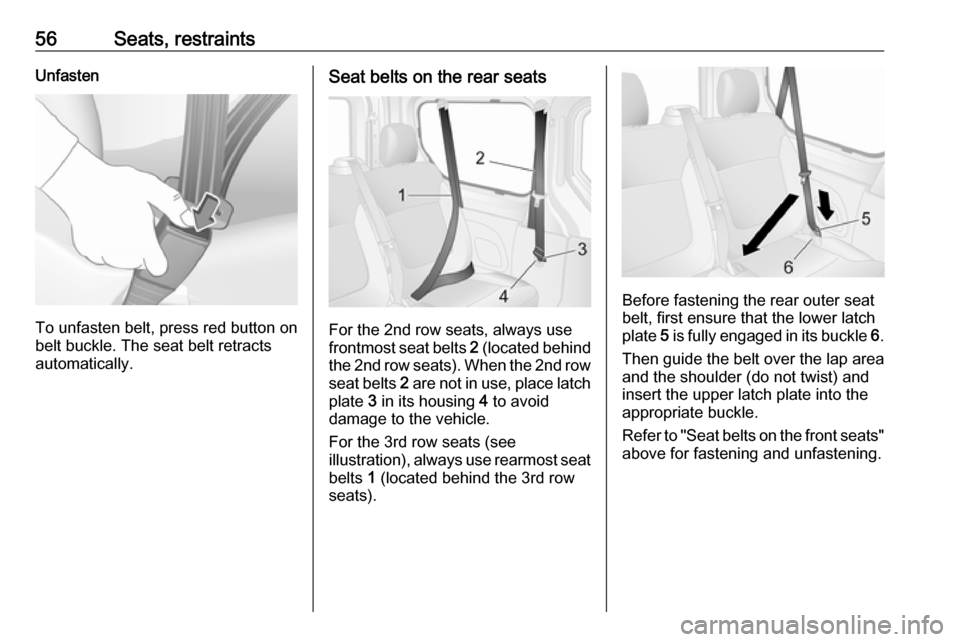
56Seats, restraintsUnfasten
To unfasten belt, press red button on
belt buckle. The seat belt retracts automatically.
Seat belts on the rear seats
For the 2nd row seats, always use
frontmost seat belts 2 (located behind
the 2nd row seats). When the 2nd row
seat belts 2 are not in use, place latch
plate 3 in its housing 4 to avoid
damage to the vehicle.
For the 3rd row seats (see
illustration), always use rearmost seat
belts 1 (located behind the 3rd row
seats).
Before fastening the rear outer seat
belt, first ensure that the lower latch
plate 5 is fully engaged in its buckle 6.
Then guide the belt over the lap area and the shoulder (do not twist) and
insert the upper latch plate into the
appropriate buckle.
Refer to "Seat belts on the front seats"
above for fastening and unfastening.
Page 59 of 231
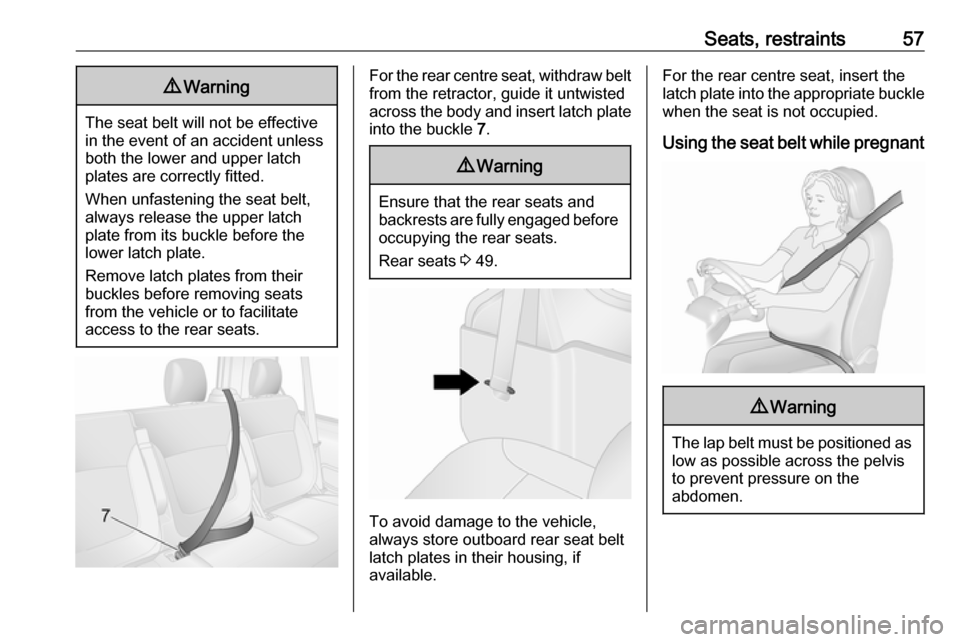
Seats, restraints579Warning
The seat belt will not be effective
in the event of an accident unless both the lower and upper latch
plates are correctly fitted.
When unfastening the seat belt,
always release the upper latch
plate from its buckle before the lower latch plate.
Remove latch plates from their
buckles before removing seats
from the vehicle or to facilitate
access to the rear seats.
For the rear centre seat, withdraw belt from the retractor, guide it untwisted
across the body and insert latch plate
into the buckle 7.9 Warning
Ensure that the rear seats and
backrests are fully engaged before occupying the rear seats.
Rear seats 3 49.
To avoid damage to the vehicle,
always store outboard rear seat belt
latch plates in their housing, if
available.
For the rear centre seat, insert the
latch plate into the appropriate buckle
when the seat is not occupied.
Using the seat belt while pregnant9 Warning
The lap belt must be positioned as
low as possible across the pelvis
to prevent pressure on the
abdomen.
Page 60 of 231
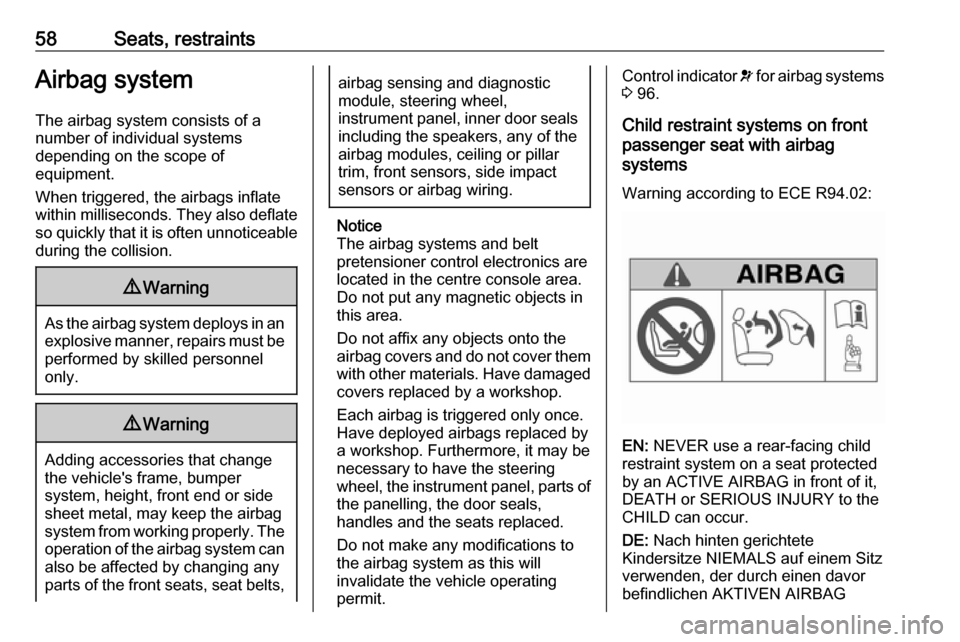
58Seats, restraintsAirbag systemThe airbag system consists of a
number of individual systems
depending on the scope of
equipment.
When triggered, the airbags inflate
within milliseconds. They also deflate
so quickly that it is often unnoticeable during the collision.9 Warning
As the airbag system deploys in an
explosive manner, repairs must be
performed by skilled personnel
only.
9 Warning
Adding accessories that change
the vehicle's frame, bumper
system, height, front end or side
sheet metal, may keep the airbag
system from working properly. The operation of the airbag system can
also be affected by changing any
parts of the front seats, seat belts,
airbag sensing and diagnostic
module, steering wheel,
instrument panel, inner door seals including the speakers, any of the
airbag modules, ceiling or pillar
trim, front sensors, side impact
sensors or airbag wiring.
Notice
The airbag systems and belt
pretensioner control electronics are
located in the centre console area.
Do not put any magnetic objects in
this area.
Do not affix any objects onto the
airbag covers and do not cover them with other materials. Have damagedcovers replaced by a workshop.
Each airbag is triggered only once.
Have deployed airbags replaced by
a workshop. Furthermore, it may be
necessary to have the steering
wheel, the instrument panel, parts of
the panelling, the door seals,
handles and the seats replaced.
Do not make any modifications to
the airbag system as this will
invalidate the vehicle operating
permit.
Control indicator v for airbag systems
3 96.
Child restraint systems on front
passenger seat with airbag
systems
Warning according to ECE R94.02:
EN: NEVER use a rear-facing child
restraint system on a seat protected
by an ACTIVE AIRBAG in front of it,
DEATH or SERIOUS INJURY to the
CHILD can occur.
DE: Nach hinten gerichtete
Kindersitze NIEMALS auf einem Sitz
verwenden, der durch einen davor
befindlichen AKTIVEN AIRBAG